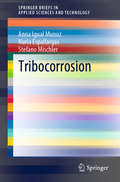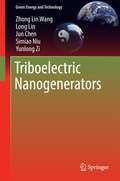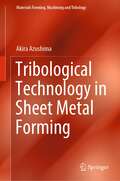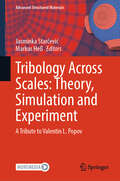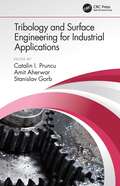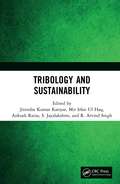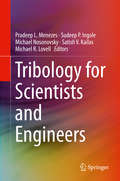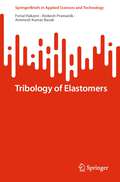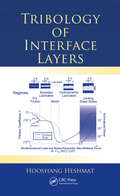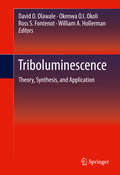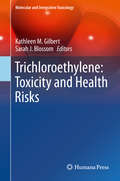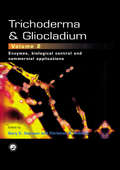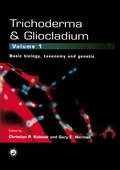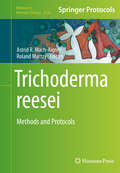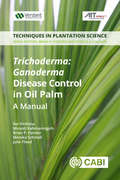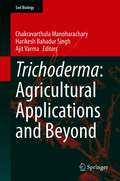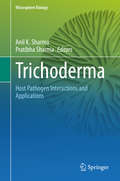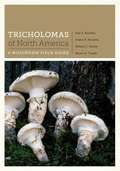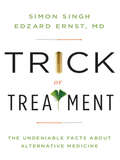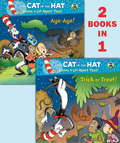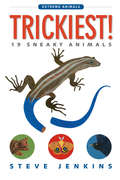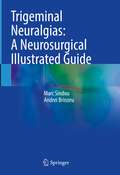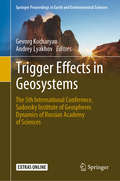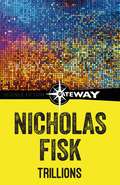- Table View
- List View
Tribocorrosion (SpringerBriefs in Applied Sciences and Technology)
by Nuria Espallargas Stefano Mischler Anna Igual MunozThis book is a toolbox for identifying and addressing tribocorrosion situations from an engineering point of view. It is an accessible and introductory guideline to the emerging and interdisciplinary field of tribocorrosion covering the main concepts of tribology and corrosion. It describes specific tribocorrosion concepts, models and experimental techniques as well as their application to practical situations in which mechanical and chemical phenomena act simultaneously.
Triboelectric Nanogenerators
by Zhong Lin Wang Jun Chen Long Lin Simiao Niu Yunlong ZiThis book introduces an innovative and high-efficiency technology for mechanical energy harvesting. The book covers the history and development of triboelectric nanogenerators, basic structures, working principles, performance characterization, and potential applications. It is divided into three parts: Part A illustrates the fundamental working modes of triboelectric nanogenerators with their prototype structures and theoretical analysis; Part B and Part C introduce two categories of applications, namely self-powered systems and self-powered active sensors. The book will be an ideal guide to scientists and engineers beginning to study triboelectric nanogenerators or wishing to deepen their knowledge of the field. Readers will be able to place the technical details about this technology in context, and acquire the necessary skills to reproduce the experimental setups for fabrication and measurement.
Tribological Study of Nanoparticles Enriched Bio-based Lubricants for Piston Ring–Cylinder Interaction (Springer Theses)
by Mubashir GulzarThis thesis investigates the tribological viability of bio-based base stock to which different nanoparticles were incorporated for engine piston-ring–cylinder-liner interaction. It determines experimentally the effects of lubricating oil conditions (new and engine-aged) on the friction and wear of the materials used for piston rings and cylinder liners. The specific base stock examined was a trimethylolpropane (TMP) ester derived from palm oil, and the nanoparticles were used as additives to obtain tribologically enhanced bio-based lubricants. The overall analysis of the results demonstrated the potential of nanoparticles to improve the tribological behavior of bio-based base stock for piston-ring–cylinder-liner interaction.
Tribological Technology in Sheet Metal Forming (Materials Forming, Machining and Tribology)
by Akira AzushimaThis state-of-the-art book highlights recent advances and discussions in tribological technologies in sheet metal forming. The contents focus on the fundamentals to the more complex topics such as micro contact and lubricant behaviors, FEM analysis in deep drawing process, usage of tribo-simulators, friction behavior in flat sliding, tribological numerical modeling, and simulation of seizure. This book is a useful reference for academicians and researchers in the field of lubrication, sheet metal forming, and tooling.
Tribology Across Scales: A Tribute to Valentin L. Popov (Advanced Structured Materials #211)
by Markus Heß Jasminka StarčevićThis book is dedicated to Prof. Dr. rer. nat. Valentin L. Popov, who has become an internationally recognized leading figure in the field of tribology within the past 35 years. He has collaborated with numerous scientists and researchers all over the world. His countless publications cover not only research contributions to classical tribology in mechanical engineering, but also to more modern fields such as nanotribology or biotribology. They include experimental investigations, theoretical approaches, and numerical simulations from the nanoscale to the macroscale. In tribute to the outstanding work of Prof. Popov, this book brings together advanced contributions in the field of tribology written by more than 40 distinguished scientists and researchers. MP4 File via app: download the SN More Media app for free, scan a link with play button and access MP4 File directly on your smartphone or tablet.
Tribology and Surface Engineering for Industrial Applications
by Catalin I. Pruncu, Amit Aherwar, Stanislav GorbTribology is a multidisciplinary science that encompasses mechanical engineering, materials science, surface engineering, lubricants, and additives chemistry with tremendous applications. Tribology and Surface Engineering for Industrial Applications discusses the latest in tribology and surface engineering for industrial applications. This book: Offers information on coatings and surface diagnostics Explains a variety of techniques for improved performance Describes applications in automotive, wheel and rail materials, manufacturing, and wind turbines Written for researchers and advanced students, this book encompasses a wide-ranging view of the latest in industrial applications of tribology and surface engineering for a variety of cross-disciplinary applications.
Tribology and Sustainability
by S. Jayalakshmi R. Arvind Singh Jitendra Kumar Katiyar Ankush Raina Mir Irfan Ul HaqTribology and Sustainability brings a vision of promoting a greener, cleaner and eco-friendly environment by highlighting sustainable solutions in tribology via the development of self-lubricating materials, green additives in lubricants, natural fibre-reinforced materials and biomimetic approaches. Backed by supporting schematic diagrams, data tables and illustrations for easy understanding, the book focuses on recent advancements in tribology and sustainability. Global sustainability and regional requirements are addressed through chapters on natural composites, green lubricants, biomedical systems and wind energy systems, with a dedicated chapter on a global sustainability scenario. FEATURES Highlights sustainability via new tribological approaches and how such methods are essential Covers the theoretical aspects of various tribological topics concerning mechanical and material designs for energy-efficient systems Includes practical global sustainability based on the regional requirements of tribological research and sustainable impact Reviews the tribology of green lubricants, green additives and lightweight materials Discusses topics related to biomimetics and biotribology Tribology and Sustainability will assist researchers, professionals and graduate students in tribology, surface engineering, mechanical design and materials engineering, including mechanical, aerospace, chemical and environmental engineering.
Tribology for Scientists and Engineers
by Michael Nosonovsky Pradeep L. Menezes Sudeep P. Ingole Satish V. Kailas Michael R. LovellThis book describes available tribology technologies and introdces a comprehensive overview of tribology. General, up-to-date knowledge on how tribology is approached in various related areas of research, both experimental and computational is provided.
Tribology of Elastomers (SpringerBriefs in Applied Sciences and Technology)
by Alokesh Pramanik Ferial Hakami Animesh Kumar BasakThis book highlights the tribological behavior of elastomers by investigating the effect of operating variables such as, the applied load and the abrasive particle size, and the materials’ mechanical properties such as, tensile strength, elongation at break, hardness, and tear strength by the experimental, statistical and analytical methods. It is found that the wear mechanism is mostly friction wear, which is mixed with fatigue wear and abrading under higher applied loads or larger abrasives. The statistical method shows that the abrasive particle size has the highest contribution followed by the applied load on the wear process. Wear equation is developed to predict the wear rate considering the trends of the input variables.
Tribology of Interface Layers
by Hooshang HeshmatTo this point, the field of lubrication has been conceptualized using several noncontiguous modes of operation- boundary, fluid-film, and dry and solid lubrication. Engineers and analysts have long had to deal with old evidence that many tribological devices, such as flat surface and centrally pivoted sliders, can act as viable bearings- contradict
Triboluminescence
by David O. Olawale Okenwa O. I. Okoli Ross S. Fontenot William A. HollermanThis book expounds on progress made over the last 35 years in the theory, synthesis, and application of triboluminescence for creating smart structures. It presents in detail the research into utilization of the triboluminescent properties of certain crystals as new sensor systems for smart engineering structures, as well as triboluminescence-based sensor systems that have the potential to enable wireless, in-situ, real time and distributed (WIRD) structural health monitoring of composite structures. The sensor component of any structural health monitoring (SHM) technology -- measures the effects of the external load/event and provides the necessary inputs for appropriate preventive/corrective action to be taken in a smart structure -- sits at the heart of such a system. This volume explores advances in materials properties and structural behavior underlying creation of smart composite structures and sensor systems for structural health monitoring of critical engineering structures, such as bridges, aircrafts, and wind blades.
Trichloroethylene: Toxicity and Health Risks
by Kathleen M. Gilbert Sarah J. BlossomA comprehensive overview of the effects of trichloroethylene toxicity caused by real-life exposure levels highlighting how exposure to trichloroethylene may contribute to the etiology of several idiopathic human diseases. Discussion will focus on different kinds of modeling and how they may be used to predict functional consequences and to dissect the contribution of different mechanistic pathways, including potential mechanisms of action for trichloroethylene toxicity in different organ systems. It will explore the role of epigenetic alterations in trichloroethylene toxicity, this provides important mechanistic information and may also provide the basis for intervention therapy. Chapters will also explain how the risks from trichloroethylene exposure may be greater in certain populations based on genetic predisposition, age of exposure and co-exposure to other chemicals With contributions from international experts in the field, Trichloroethylene: Toxicity and Health Risks is an essential resource for researchers and clinicians in toxicology, immunology, medicine and public health as well as industry and government regulatory scientists involved in safety and health protection and epidemiologists, highlighting the need for interdisciplinary cooperation in solving issues of environmental toxicity.
Trichoderma And Gliocladium, Volume 2: Enzymes, Biological Control and commercial applications
by Christian P. Kubicek Gary E. HarmanFungi belonging to the genera Trichoderma and Gliocladium are soil- bourne saprophytes which have been used for industrial and agricultural applications for decades. Some strains produce enzymes and antibiotics while others are useful as biological agents for the protection of plants against pathogens.
Trichoderma And Gliocladium. Volume 1: Basic Biology, Taxonomy and Genetics
by Christian P. Kubicek Gary E. HarmanThis volume gives an account of the morphology and taxonomy of "Trichoderma" and "Gliocladium", before disscusing their ecology and basic biology.
Trichoderma reesei: Methods and Protocols (Methods in Molecular Biology #2234)
by Astrid R. Mach-Aigner Roland MartzyThis detailed book collects standard techniques and cutting-edge methods that are frequently used by the research community studying the fungus Trichoderma reesei. Beginning with overviews of its evolution, its use in the production of industrially-relevant enzymes, and synthetic biology applications, the volume continues with methods covering topics from transformation techniques and gene editing to downstream-analytical applications and -omics analyses and the corresponding bioinformatics approaches. Written for the highly successful Methods in Molecular Biology series, chapters include introductions to their respective topics, lists of the necessary materials and reagents, step-by-step, readily reproducible laboratory protocols, and tips on troubleshooting and avoiding known pitfalls. Authoritative and practical, Trichoderma reesei: Methods and Protocols serves as an ideal guide for a wide range of audiences, from students who want to familiarize themselves with basic research protocols to experienced scientists who are planning to establish a new method in their laboratories, working with this dynamic fungus.
Trichoderma: A Manual (Techniques in Plantation Science)
by Julie Flood Brian Forster Miranti Rahmaningsih Ike VirdianaThis is a hands-on practical guide to the use of Trichoderma as a biocontrol, as part of sustainable disease control measures for Ganoderma disease in oil palm plantations. The manual provides background information on Ganoderma (basal stem rot), the most devastating disease of oil palm in Southeast Asia, as well as on the benefits of Trichoderma fungi in safe guarding yields. The disease is caused by soil-borne fungi, Ganoderma spp, which are found in West Africa and South America, as well as Southeast Asia. Practical information is given on: the use of Trichoderma to manage Ganoderma for research and commercial use health and safety considerations in the laboratory, nursery and field in vitro multiplication of Trichoderma starting from media preparation and culture Ganoderma pathogenicity testing Trichoderma in vitro antagonism screening of Ganoderma Trichoderma screening to protect seedlings scoring Ganoderma response to Trichoderma in selecting aggressive Trichoderma isolates commercial use and application in oil palm plantations This is an invaluable manual for oil palm growers, estate/plantation managers, pathologists and breeders and research institutes across the world (especially tropical zones). It is also useful for those starting a career in oil palm plant protection, and as a reference guide for managers and for training purposes.
Trichoderma: Agricultural Applications and Beyond (Soil Biology #61)
by Ajit Varma Harikesh Bahadur Singh Chakravarthula ManoharacharyThis book gives a comprehensive overview on the various aspects of Trichoderma, a filamentous fungus ubiquitously present in soil. Topics addressed are the biology, diversity, taxonomy, ecology, biotechnology and cultivation of Trichoderma, to just name a few. Basic as well as applied aspects are covered and a special focus is given on use of Trichoderma in agriculture and beyond. Trichoderma species are widely distributed throughout the world in soil, rotting plant material, and wood. Although they are often considered as a contaminants, Trichoderma species are also known for their ability to act as biocontrol agents against various plant pathogens and plant diseases, and also as biostimulants promoting plant growth. The contents of this book will be of particular interest to, agricultural scientists, biotechnologists, plant pathologists, mycologists, and microbiologists, students, extension workers, policy makers and other stakeholders.
Trichoderma: Host Pathogen Interactions and Applications (Rhizosphere Biology)
by Anil K. Sharma Pratibha SharmaThis book compiles the latest research in the area of Trichoderma Rhizosphere Biology. It covers topics such as microbial interaction, crosstalk between plants and microbes, interactions with abiotic and biotic factors, and advances in biocontrol agents, biofertilizers and biostimulants. The respective chapters describe innovative ways of adapting fungal communities to improve their survival in highly dynamic environments and agroecosystems. In closing, the book discusses the use of Trichoderma as a bio-growth enhancer and biostimulant for organic agriculture.
Tricholomas of North America: A Mushroom Field Guide
by Alan E. Bessette Arleen R. Bessette William C. Roody Steven A. TrudellMore than 100 mushrooms in the genus Tricholoma have been reported in North America. Most are relatively large, showy mushrooms that grow on the ground near many species of temperate forest trees, both hardwoods and conifers. They typically fruit from late summer through early winter or even into spring in warmer areas. Some are fine edibles, including the Matsutake. Others are inedible or even poisonous. Filling the gap between technical publications and the limited representation of Tricholomas in general mushroom field guides, this book is the first comprehensive guide to North American Tricholomas. It contains more than 170 of the best documentary photographs available, often with more than one image of a species to illustrate the dramatic variation exhibited by many Tricholomas. The species descriptions provide extensive identification information including scientific and common names, macroscopic and microscopic features, occurrence/habit, edibility, and a comment section that addresses such things as synonomy, comparisons with similar species, varietial differences, explanations of species' epithets, and other useful or interesting information. In addition, the authors provide a general introduction to Tricholomas that discusses identification features, ecology, simple chemical tests (for identification), and how to use the keys provided in this book.
Trick or Treatment: The Undeniable Facts about Alternative Medicine
by Simon Singh Edzard ErnstThe truth about the potions, lotions, pills and needles, pummelling and energizing that lie beyond the realms of conventional medicine. Whether you are an ardent believer in alternative medicine, a skeptic, or are simply baffled by the range of services and opinions, this guide lays to rest doubts and contradictions with authority, integrity, and clarity. In this groundbreaking analysis, over thirty of the most popular treatments--acupuncture, homeopathy, aromatherapy, reflexology, chiropractic, and herbal medicines--are examined for their benefits and potential dangers. Questions answered include: What works and what doesn't? What are the secrets, and what are the lies? Who can you trust, and who is ripping you off? Can science decide what is best, or do the old wives' tales really tap into ancient, superior wisdom?In their scrutiny of alternative and complementary cures, authors Simon Singh and Edzard Ernst also strive to reassert the primacy of the scientific method as a means for determining public health practice and policy.
Trick-or-Treat!/Aye-Aye! (Pictureback(R))
by Joe Mathieu Tish RabeIt's no trick--fans of the PBS Kids television show The Cat in the Hat Knows a Lot About That! are in for a treat this Halloween with two holiday stories. In Trick-or-Treat!, the Cat and kids visit with a spider monkey, a coconut crab, and a fruit bat to see some amazing tricks and to sample some exotic healthy treats. And in Aye-Aye!, when Sally and Nick need help making scary Halloween masks, the Cat knows just what to do. He takes them to visit an aye-aye--a creepy-looking creature whose frightening looks are perfectly adapted for his environment. All in all, this is a Halloween treat sure to make parents, kids--and dentists--smile!
Trickiest!: 19 Sneaky Animals (Extreme Animals)
by Steve JenkinsTrickiest! introduces readers to some of the slyest animals on the planet, and the award-winning author and illustrator Steve Jenkins is here to show you what earned them their reputation. Steve's Extreme Animals reader series explores nature's truly superlative animals with the help of illustrations, infographics, facts, and figures while detailing the astounding abilities of critters as small as a frog or as big as a whale. Each installment focuses on truly amazing and unusual animals, making these nonfiction readers accessible, informative, and fascinating.
Trigeminal Neuralgias: A Neurosurgical Illustrated Guide
by Marc Sindou Andrei BrinzeuThis book is focused on trigeminal neuralgias and their management, a field in which, during the two past decades, there were numerous advances in comprehension of mechanisms of the disease and diagnosis with imaging, as well as in medical therapies and in surgical treatment. The authors are well-known specialists for this treatment and summarize their long experience in this comprehensive and practical book. They are experts not only on the surgical treatment of trigeminal neuralgia with the micro-vascular decompression procedure but also with the lesioning procedures. In this pictorial guide, readers can find the pathways for diagnosis, and practical guidelines to help decision-making among the most appropriate treatments, tailored on to every patient’s need. Neurologists, neurosurgeons, and dentists, but also ENT specialists, ophthalmologists, and maxillofacial specialists, would find an invaluable support in this book devoted to a rather frequent problem to deal with.
Trigger Effects in Geosystems: The 5th International Conference, Sadovsky Institute of Geospheres Dynamics of Russian Academy of Sciences (Springer Proceedings in Earth and Environmental Sciences)
by Gevorg Kocharyan Andrey LyakhovThis book is the result of collaboration within the frames of the 5th International Conference "Trigger Effects in Geosystems" held in the Institute of Geosphere Dynamics of Russian Academy of Sciences, June 2019. This book aims to raise awareness about different triggering aspects in the geosphere and its effects.The conference provided a multidisciplinary platform with a focus on (i) the influence of natural and anthropogenic factors on the geosphere, geomechanical systems and anthropogenic objects found in a subcritical state and (ii) the influence of these factors on the system “atmosphere - ionosphere”.The problems considered in the book may be interesting for a wide audience including students, professionals, researches, and for the industry.
Trillions
by Nicholas FiskTrillions were hard, bright, tiny things which suddenly arrived - millions and millions and millions of them - one windy day in a village called Harbourtown.No one could explain them, much less why they had suddenly arrived. Were they a blessing, as their beauty suggested, or a deadly, inexplicable threat? A boy with a microscope was just as likely to come up with the answer as all the acknowledged experts in any known kind of science, so somehow it seemed natural for two 'ordinary' boys, Scott and Bem, to join forces with an ex-spaceman against the frightening efforts of the ruthless General Harman to destroy the Trillions, no matter what the cost.
